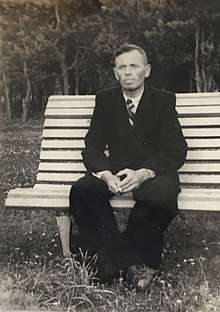Leiba Dobrovskii
Leyba-Itzko Dobrovsky or Dobrovskii (Лейба Іцик Добровський; 1910–1969)[1] was a Jewish Ukrainian soldier of the Soviet Red Army who was captured prisoner and hid his ethnic identity to survive the Holocaust.

Early life and education
Dobrovskii was born in 1910 in Olshanitsa of the Rokitnyansky district in the Kiev region to parents Josip and Perl. He went on to graduate from the Law Faculty of the Kiev State University and was accepted into the Communist Party of Ukraine, with membership No. 24170.[1]
War combat
Dobrovskii was drafted for military service on 22 June 1941, in the 5th Army, as soon as Nazi Germany invaded, and was sent to the Railway District's Military Committee of the city of Kiev assigned to work there as administrative clerk at one of the evacuation points.[1]
In the first days and weeks of the German invasion, the 5th Army fought against forces from the German Army Group South, defending areas leading to Lutsk. The 5th Army suffered defeats and heavy losses, retreating to Poltava. On 20 September 1941, the remnants of the army were surrounded by the Germans and their commander was seriously wounded and captured. Dobrovskii was among those taken prisoner but managed to escape from captivity. In subsequently discovered Soviet documents, he was listed as having "disappeared" by October 1941.[1]
Ukrainian nationalist forces
The accounts about Dobrovskii's actions after his escape differ among historians.
In the 21st century, Ukrainian historian Volodymyr Viatrovych has claimed that Dobrovskii was a Jew who fought alongside the Ukrainian Insurgent Army (UPA) against the Nazis and the Soviets.[2] An account by Dobrovskii's alleged niece, living in Israel, ostensibly confirmed the Viatrovych version of events,[1] in which Dobrovskii worked for the Ukrainians openly as a Jew and published pamphlets inviting people living in the country of all ethnic backgrounds to join in the struggle of the UPA.[3]
Viatrovych presented the case of Leiba Dobrovskii, who, he claimed, rose to become political advisor to a UPA commander while openly being Jewish, and published leaflets about "the [peaceful] coexistence of Jews and Ukrainians for thousands of years," as evidence of the lies of "[Soviet propaganda] allegations of anti-Semitism [within] the Ukrainian national liberation movement."[4] Viatrovych also claimed that the participation of Ukrainians from Bukovina in the extermination of Jews in Babi Yar was a "Soviet myth."[4] The BBC subsidiary in Ukraine supported this version of events.[5]
Historian Jared McBride,[6] in a 2017 Haaretz article, dismissed the "myth of Jews happily serving with Ukrainian nationalists," which grew, as he claimed, after the Orange Revolution and historian Viatrovych's increased prominence within the Ukrainian government wherefrom he promoted the Dobrovskii "legend."[2]
According to McBride, the escaped prisoner Dobrovskii went to north-western Ukraine, where he accidentally met local Ukrainian nationalists "connected to the local collaborationist police and administration," including the local mayor and later UPA member, Mykola Kryzhanovskii. McBride notes that Kryzhanovskii was "well-known for his brutality towards Jews", but the nationalists, not suspecting that Dobrovskii was Jewish, recruited him to produce propaganda on account of his education. Dobrovskii thus concealed his Jewishness and, moreover, was "not an enthusiastic supporter of Ukrainian nationalism." The basis for McBride's version of events is Dobrovskii's arrest file kept in the Security Service of Ukraine archives, which was presented publicly in 2008 as part of an exhibition organized by the Ukrainian Institute of National Remembrance, with the assistance of Viatrovych himself.[2]
Implications
The case of Leiba Dobrosvskii has been presented as evidence of the Ukrainian nationalist forces' alleged lack of anti-semitism. A similar argument was made with the case of an alleged Jewish UPA fighter named Stella Krenzbach, whose ostensible memoirs were first published in the Ukrainian diaspora in 1954 and in Ukraine in 1993. Historian John-Paul Himka, in 2011, dismissed the Krenzbach "legend" as a fabrication of UPA and the Organization of Ukrainian Nationalists and their promoters, who, he stated, "have to resort to falsifications to defend their innocence vis-à-vis the Holocaust."[7]
See also
- Ukrainian nationalism
- Reichskommissariat Ukraine
- Mizocz Ghetto
References
- Nechytailo, Alexander (6 June 2018). "Неймовірна одіссея київського єврея, який боровся за незалежність України в лавах УПА" [The Incredible Odyssey of a Kiev Jew who fought for Ukraine's independence in the UPA ranks]. Vector News (in Ukrainian). Retrieved 19 July 2018.
- McBride, Jared (9 November 2017). "Ukraine's Invented a 'Jewish-Ukrainian Nationalist' to Whitewash Its Nazi-era Past". Haaretz. Retrieved 16 July 2018.
- Shurkhalo, Dmitry (13 October 2017). "Бандерівський інтернаціонал: неукраїнці в лавах УПА" [Bandera International: non-Ukrainians in the ranks of the UPA]. Radio Svoboda (in Ukrainian). Retrieved 19 July 2018.
- Minyailo, Natalia (29 May 2015). "Історія Євреї в Україні були меншиною в меншині : В'ятрович" [Vyatrovich: Jews in Ukraine were a minority in the minority]. Gazeta (in Ukrainian). Retrieved 19 July 2018.
- Krupnytsky, Lubomyr (15 April 2008). "Євреї в УПА?" [Jews in the UPA?]. BBC Ukrainian (in Ukrainian). Retrieved 19 July 2018.
- "Impact in Profile: Jared McBride". USC Shoah Foundation Center for Advanced Genocide Research. Retrieved 20 July 2018.
- Himka, John-Paul (8 May 2011). "Falsifying World War II history in Ukraine". Kyiv Post. Retrieved 18 July 2018.
Further reading
- Friedman, Philip (1980). "Ukrainian-Jewish Relations During the Nazi Occupation". Roads to Extinction: Essays on the Holocaust. Jewish Publishing Society. ISBN 978-0827601703.
- Mick, Christoph (2011). "Incompatible Experiences: Poles, Ukrainians and Jews in Lviv under Soviet and German Occupation, 1939–44" (PDF). Journal of Contemporary History. 46 (2): 336–363. doi:10.1177/0022009410392409. Retrieved 21 July 2018.